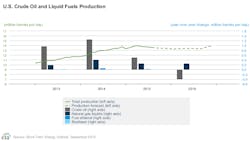STEO: Global oil consumption revised down on weak China economic data
In its most recent Short-Term Energy Outlook, the US Energy Information Administration reported it expects global oil consumption to increase 1.2 million b/d in 2015 and 1.3 million b/d in 2016. Growth in global consumption for 2016 was revised downward by nearly 200,000 b/d compared with last month’s forecast, as China and other Asian economies continue to show signs of weakness.
EIA estimates production outside the Organization of Petroleum Exporting Countries to rise 1.4 million b/d in 2015, but to remain flat in 2016, as declining US production is offset by modest growth in other non-OPEC producers.
“Non-OPEC production growth in 2015 is largely attributable to investments made when oil prices were higher,” EIA said. “For example, the decisions to invest in the Golden Eagle, Peregrine and Kinnoull fields in the UK’s sector of the North Sea were made in the second half of 2011 when Brent crude prices were more than $100/bbl.”
Production growth in Canada is expected to average 300,000 b/d in both 2015 and 2016, driven by continued expansion in oil sands projects. “Although some previously announced oil sands projects have been put on hold, the vast majority continue as planned, including Imperial Oil and Cenovus oil sands projects scheduled to come online by the end of 2016,” EIA said.
OPEC crude oil production is expected to rise 800,000 b/d in 2015 and remain relatively flat in 2016. Iraq is expected to be the largest contributor to OPEC production growth over the next 2 years. In 2016, additional OPEC crude oil supply is expected to come from Iran, which is forecast to boost production if international sanctions targeting its oil sector are suspended.
Global oil inventory builds in this year’s second quarter averaged 2.9 million b/d compared with 1.9 million b/d in the first quarter. The pace of inventory builds is expected to slow in this year’s second half to about 1.8 million b/d. In 2016, inventory builds are forecast to slow to an average of 1.1 million b/d.
US market
EIA forecasts that US motor gasoline consumption will rise 210,000 b/d, or 2.3%, in 2015 as the effects of employment growth and lower gasoline prices outweigh increases in vehicle fleet efficiency. Gasoline consumption is forecast to remain flat in 2016 as a long-term trend toward vehicles that are more fuel efficient offsets the effect of continued economic growth on highway travel.
Consumption of distillate fuel is forecast to be relatively unchanged in 2015 and then increase 60,000 b/d, or 1.5%, in 2016.
Total US crude oil production is forecast to increase from an average of 8.7 million b/d in 2014 to 9.2 million b/d in 2015 and then decrease to 8.8 million b/d in 2016. For both 2015 and 2016, the forecast is about 100,000 b/d lower than in the August STEO, mostly reflecting downward revisions to US oil production estimates for this year’s first half.
Based on EIA’s revised data, US crude oil production averaged 9.4 million b/d in this year’s first half. Lower 48 onshore production began falling in April, but the decline was offset by production gains in the Gulf of Mexico that kept total production growth positive until May. Total US production began declining in May, falling more than 200,000 b/d from the April level.
EIA expects that the decline will continue through August 2016, largely attributable to unattractive economic returns in some areas of both emerging and mature onshore oil production regions, as well as seasonal factors such as anticipated hurricane-related production disruptions in the Gulf of Mexico.


